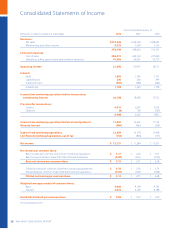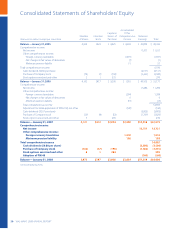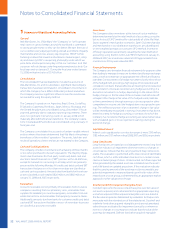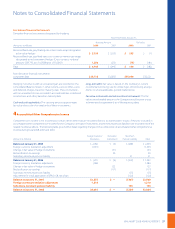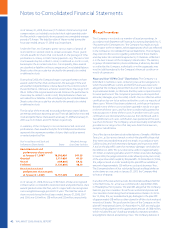Walmart 2008 Annual Report Download - page 35
Download and view the complete annual report
Please find page 35 of the 2008 Walmart annual report below. You can navigate through the pages in the report by either clicking on the pages listed below, or by using the keyword search tool below to find specific information within the annual report.
Notes to Consolidated Financial Statements
WAL-MART 2008 ANNUAL REPORT 33
assets are considered long-lived assets and are amortized on a
straight-line basis over the periods that expected economic benets
will be provided.
Indenite-lived other acquired intangible assets are evaluated for
impairment based on their fair values using valuation techniques
which are updated annually based on the most recent variables
and assumptions.
Goodwill is evaluated for impairment by determining the fair value of
the related reporting unit. Fair value is measured based on a discounted
cash ow method or relative market-based approach. The analyses
require signicant management judgment to evaluate the capacity
of an acquired business to perform within projections. Historically,
the Company has generated sucient returns to recover the cost of
the goodwill.
Goodwill is recorded on the balance sheet in the operating segments
as follows:
January 31,
(Amounts in millions) 2008 2007
International $15,766 $13,454
Sam’s Club 305 305
Total goodwill $16,071 $13,759
The change in the International segment’s goodwill since fiscal
2007 resulted primarily from the acquisition of the controlling inter-
est in Bounteous Company Ltd. (“BCL”), the tender oer to acquire
the remaining outstanding common and preferred shares of our
Japanese subsidiary, The Seiyu, Ltd. (“Seiyu”), and foreign exchange
rate uctuations.
Leases
The Company estimates the expected term of a lease by assuming
the exercise of renewal options where an economic penalty exists
that would preclude the abandonment of the lease at the end of the
initial non-cancelable term and the exercise of such renewal is at the
sole discretion of the Company. This expected term is used in the
determination of whether a store lease is a capital or operating lease
and in the calculation of straight-line rent expense. Additionally, the
useful life of leasehold improvements is limited by the expected lease
term or the economic life of the asset. If signicant expenditures are
made for leasehold improvements late in the expected term of a
lease and renewal is reasonably assumed, the useful life of the lease-
hold improvement is limited to the end of the renewal period or
economic life of the asset.
Rent abatements and escalations are considered in the calculation
of minimum lease payments in the Company’s capital lease tests and
in determining straight-line rent expense for operating leases.
Foreign Currency Translation
The assets and liabilities of all foreign subsidiaries are translated using
exchange rates at the balance sheet date. The income statements
of foreign subsidiaries are translated using average exchange rates for
the period. Related translation adjustments are recorded as a compo-
nent of accumulated other comprehensive income.
Revenue Recognition
The Company recognizes sales revenue net of sales taxes and estimated
sales returns at the time it sells merchandise to the customer, except
for layaway transactions. The Company recognizes revenue from
layaway transactions when the customer satises all payment obliga-
tions and takes possession of the merchandise. Customer purchases
of shopping cards are not recognized as revenue until the card is
redeemed and the customer purchases merchandise by using the
shopping card.
Sam’s Club Membership Fee Revenue Recognition
The Company recognizes Sam’s Club membership fee revenue both
in the United States and internationally over the term of the mem-
bership, which is 12 months. The following table details unearned
revenue, membership fees received from members and the amount
of revenue recognized in earnings for each of the scal years 2008,
2007 and 2006.
Fiscal Year Ended January 31,
(Amounts in millions) 2008 2007 2006
Deferred membership fee
revenue, beginning of year $ 535 $ 490 $ 458
Membership fees received 1,054 1,030 940
Membership fee
revenue recognized (1,038) (985) (908)
Deferred membership fee
revenue, end of year $ 551 $ 535 $ 490
Sam’s Club membership fee revenue is included in membership and
other income in the revenues section of the Consolidated Statements
of Income.
Cost of Sales
Cost of sales includes actual product cost, the cost of transportation
to the Company’s warehouses, stores and clubs from suppliers, the
cost of transportation from the Company’s warehouses to the stores
and clubs and the cost of warehousing for our Sam’s Club segment.
Payments from Suppliers
Wal-Mart receives money from suppliers for various programs, primarily
volume incentives, warehouse allowances and reimbursements for
specic programs such as markdowns, margin protection and adver-
tising. Substantially all payments from suppliers are accounted for as
a reduction of purchases and recognized in our Consolidated State-
ments of Income when the related inventory is sold.
Operating, Selling, General and Administrative Expenses
Operating, selling, general and administrative expenses include all
operating costs of the Company except those costs related to the
transportation of products from the supplier to the warehouses,
stores or clubs, the costs related to the transportation of products
from the warehouses to the stores or clubs and the cost of warehous-
ing for our Sam’s Club segment. As a result, the cost of warehousing
and occupancy for our Wal-Mart Stores and International segments’
distribution facilities are included in operating, selling, general and
administrative expenses. Because we do not include the cost of our







